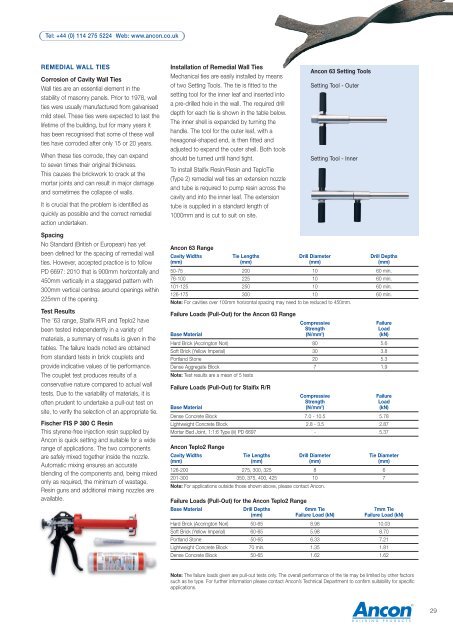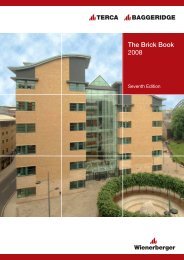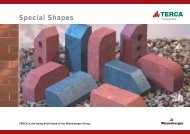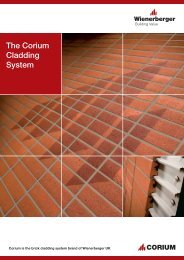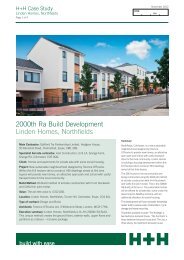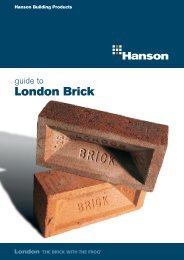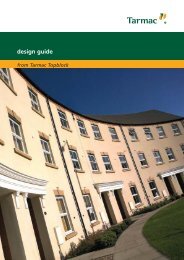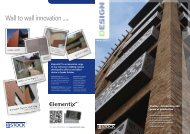Wall Ties and Restraint Fixings - Masonry First
Wall Ties and Restraint Fixings - Masonry First
Wall Ties and Restraint Fixings - Masonry First
- No tags were found...
You also want an ePaper? Increase the reach of your titles
YUMPU automatically turns print PDFs into web optimized ePapers that Google loves.
Tel: +44 (0) 114 275 5224 Web: www.ancon.co.ukREMEDIAL WALL TIESCorrosion of Cavity <strong>Wall</strong> <strong>Ties</strong><strong>Wall</strong> ties are an essential element in thestability of masonry panels. Prior to 1978, wallties were usually manufactured from galvanisedmild steel. These ties were expected to last thelifetime of the building, but for many years ithas been recognised that some of these wallties have corroded after only 15 or 20 years.When these ties corrode, they can exp<strong>and</strong>to seven times their original thickness.This causes the brickwork to crack at themortar joints <strong>and</strong> can result in major damage<strong>and</strong> sometimes the collapse of walls.It is crucial that the problem is identified asquickly as possible <strong>and</strong> the correct remedialaction undertaken.SpacingNo St<strong>and</strong>ard (British or European) has yetbeen defined for the spacing of remedial wallties. However, accepted practice is to followPD 6697: 2010 that is 900mm horizontally <strong>and</strong>450mm vertically in a staggered pattern with300mm vertical centres around openings within225mm of the opening.Test ResultsThe '63 range, Staifix R/R <strong>and</strong> Teplo2 havebeen tested independently in a variety ofmaterials, a summary of results is given in thetables. The failure loads noted are obtainedfrom st<strong>and</strong>ard tests in brick couplets <strong>and</strong>provide indicative values of tie performance.The couplet test produces results of aconservative nature compared to actual walltests. Due to the variability of materials, it isoften prudent to undertake a pull-out test onsite, to verify the selection of an appropriate tie.Fischer FIS P 380 C ResinThis styrene-free injection resin supplied byAncon is quick setting <strong>and</strong> suitable for a widerange of applications. The two componentsare safely mixed together inside the nozzle.Automatic mixing ensures an accurateblending of the components <strong>and</strong>, being mixedonly as required, the minimum of wastage.Resin guns <strong>and</strong> additional mixing nozzles areavailable.Installation of Remedial <strong>Wall</strong> <strong>Ties</strong>Mechanical ties are easily installed by meansof two Setting Tools. The tie is fitted to thesetting tool for the inner leaf <strong>and</strong> inserted intoa pre-drilled hole in the wall. The required drilldepth for each tie is shown in the table below.The inner shell is exp<strong>and</strong>ed by turning theh<strong>and</strong>le. The tool for the outer leaf, with ahexagonal-shaped end, is then fitted <strong>and</strong>adjusted to exp<strong>and</strong> the outer shell. Both toolsshould be turned until h<strong>and</strong> tight.To install Staifix Resin/Resin <strong>and</strong> TeploTie(Type 2) remedial wall ties an extension nozzle<strong>and</strong> tube is required to pump resin across thecavity <strong>and</strong> into the inner leaf. The extensiontube is supplied in a st<strong>and</strong>ard length of1000mm <strong>and</strong> is cut to suit on site.Ancon 63 RangeCavity Widths Tie Lengths Drill Diameter Drill Depths(mm) (mm) (mm) (mm)50-75 200 10 60 min.76-100 225 10 60 min.101-125 250 10 60 min.126-175 300 10 60 min.Note: For cavities over 100mm horizontal spacing may need to be reduced to 450mm.Failure Loads (Pull-Out) for the Ancon 63 RangeCompressiveFailureStrengthLoadBase Material (N/mm 2 ) (kN)Hard Brick (Accrington Nori) 80 5.6Soft Brick (Yellow Imperial) 30 3.8Portl<strong>and</strong> Stone 20 5.3Dense Aggregate Block 7 1.9Note: Test results are a mean of 5 testsFailure Loads (Pull-Out) for Staifix R/RAncon 63 Setting ToolsSetting Tool - OuterSetting Tool - InnerCompressiveFailureStrengthLoadBase Material (N/mm 2 ) (kN)Dense Concrete Block 7.0 - 10.5 5.78Lightweight Concrete Block 2.8 - 3.5 2.87Mortar Bed Joint, 1:1:6 Type (iii) PD 6697 - 5.37Ancon Teplo2 RangeCavity Widths Tie Lengths Drill Diameter Tie Diameter(mm) (mm) (mm) (mm)126-200 275, 300, 325 8 6201-300 350, 375, 400, 425 10 7Note: For applications outside those shown above, please contact Ancon.Failure Loads (Pull-Out) for the Ancon Teplo2 RangeBase Material Drill Depths 6mm Tie 7mm Tie(mm) Failure Load (kN) Failure Load (kN)Hard Brick (Accrington Nori) 50-65 8.98 10.03Soft Brick (Yellow Imperial) 60-65 5.98 8.70Portl<strong>and</strong> Stone 50-65 6.33 7.21Lightweight Concrete Block 70 min. 1.35 1.81Dense Concrete Block 50-65 1.62 1.62Note: The failure loads given are pull-out tests only. The overall performance of the tie may be limited by other factorssuch as tie type. For further information please contact Ancon’s Technical Department to confirm suitability for specificapplications.29


